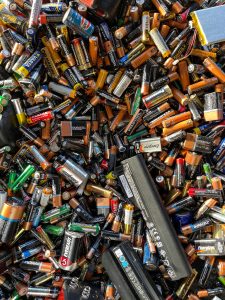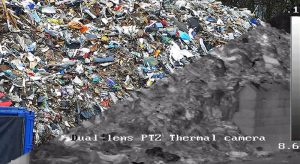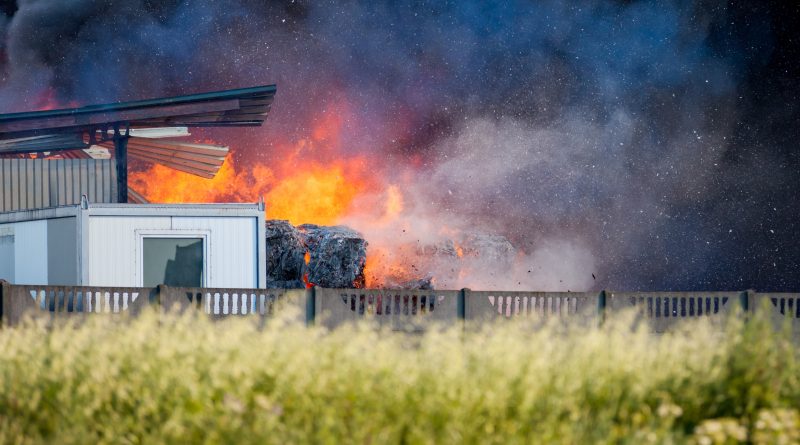Catching waste fires before they happen
Waste fires – in other words fires that occur in the waste dumping facility or recycling plants – is a very serious global issue. Countries all over the world are suffering from more than one fire per day in the waste and recycling industry. This causes risk of injury to employees, damage to sites and machinery, and damage to reputation. And that’s even before you consider the potential environmental impact. There’s more irony here too – one of the biggest risks for fire at a waste dumping facility is damaged lithium-ion batteries. These batteries are rechargeable and thus designed to be more sustainable!
What causes waste fires?
 As the human race creates more and more waste, recycling has become crucial in the fight for sustainability. Numerous recycling plants are built to deal with all kinds of materials, turning them into something useable again.
As the human race creates more and more waste, recycling has become crucial in the fight for sustainability. Numerous recycling plants are built to deal with all kinds of materials, turning them into something useable again.
Many of these materials are combustible – paper and cardboard, for example. The materials are also compressed together in order to save space. A dry, hot spell of weather can also add a rise in heat within this pile. All these conditions combine to make a potentially combustible situation – all is needed is a spark.
This is an example of what’s known in the industry as ‘scalding’. Heat can build up unchecked in places that cannot be seen or monitored in traditional ways. In the middle of a waste pile, for example. There’s also no smoke to be seen here, since it’s shielded by outer layers of the waste.
Danger can come from various places – but increasingly the culprit is rechargeable batteries. In fact, according to a recent WEEE report[1], most severe fires caused by batteries in the last four years caused damage costing an average of €1.3 million. The lithium-ion technology in these batteries works by using different chemicals in separate cells. The ‘walls’ of these cells are quite thin, to make the battery lightweight. When damaged, these can be punctured, or short-circuited combining the separated elements and causing either a build-up of heat, leading to a fire, or even an explosion.
Tackling waste fires
 Traditional methods of tackling the problem are based on reacting quickly to a waste fire once it breaks out. Fire alarms and sprinkler systems are used, and a ‘hotline’ to the local fire services could be prudent. Sites also use sirens and lights to warn people of the danger.
Traditional methods of tackling the problem are based on reacting quickly to a waste fire once it breaks out. Fire alarms and sprinkler systems are used, and a ‘hotline’ to the local fire services could be prudent. Sites also use sirens and lights to warn people of the danger.
However, these measures all come into effect once a fire has started. Technology can now be used to tackle the issue before it happens. In other words, to detect the build-up of heat, before the spark has ignited the fire. It succeeds in managing the risks of harm to employees or visitors to the site. It’s also good for the budget – reducing the costs and work to repair any fire damage.
Enter Hikvision
Thermal cameras are used to monitor temperatures both inside and outside of a plant. These cameras can be configured to raise an alarm when a predefined temperature is monitored, and then again when a higher one is reached.
The first temperature limit is for a ‘pre-alarm’, which will have the camera send a signal once the temperature is higher than normal. The second limit should be configured at a critical temperature, so that it’s clear that immediate action is necessary once it’s heard.
Both alarms can be verified by employees monitoring the situation, both on and off-site, using a bi-spectrum camera. This provides live images alongside the thermal ones, giving more context to the issue. Then, armed with verified situational information, appropriate persons can take action to prevent, or put out, any waste fires. This could be one of the employees present on the site, or via a remote monitoring service. Using HikCentral video management software, images can also be sent to managers remotely. They are able to see what’s happening via tablet or mobile, wherever they are.
The solution uses smart algorithms to ensure that hot spots caused by sunlight, or cars moving through the site, do not cause false alarms. It can also be seamlessly connected to other fire repressing systems, like sprinklers or automated fire doors.
The world of sustainability moves on. In a world where a battery designed to be sustainable can actually cause problems when recycled, looking at the complete picture seems crucial. As is the ability to tackle problems before they happen. Using technology, recycling plants can identify potential fires before they happen. So even if the materials going through a waste site are potential fire risks, these can be effectively managed. It’s a classic example of prevention being better than cure – more relevant than ever to waste fires.

